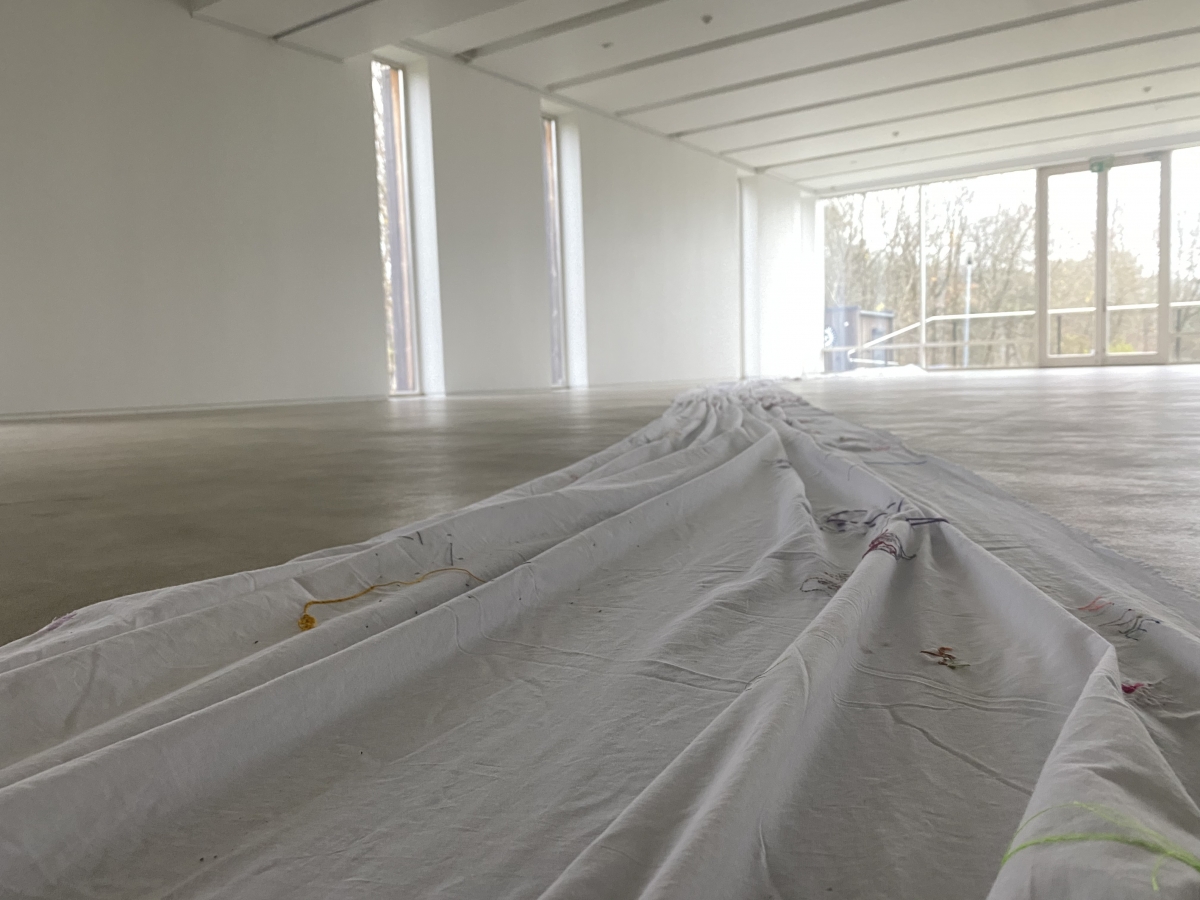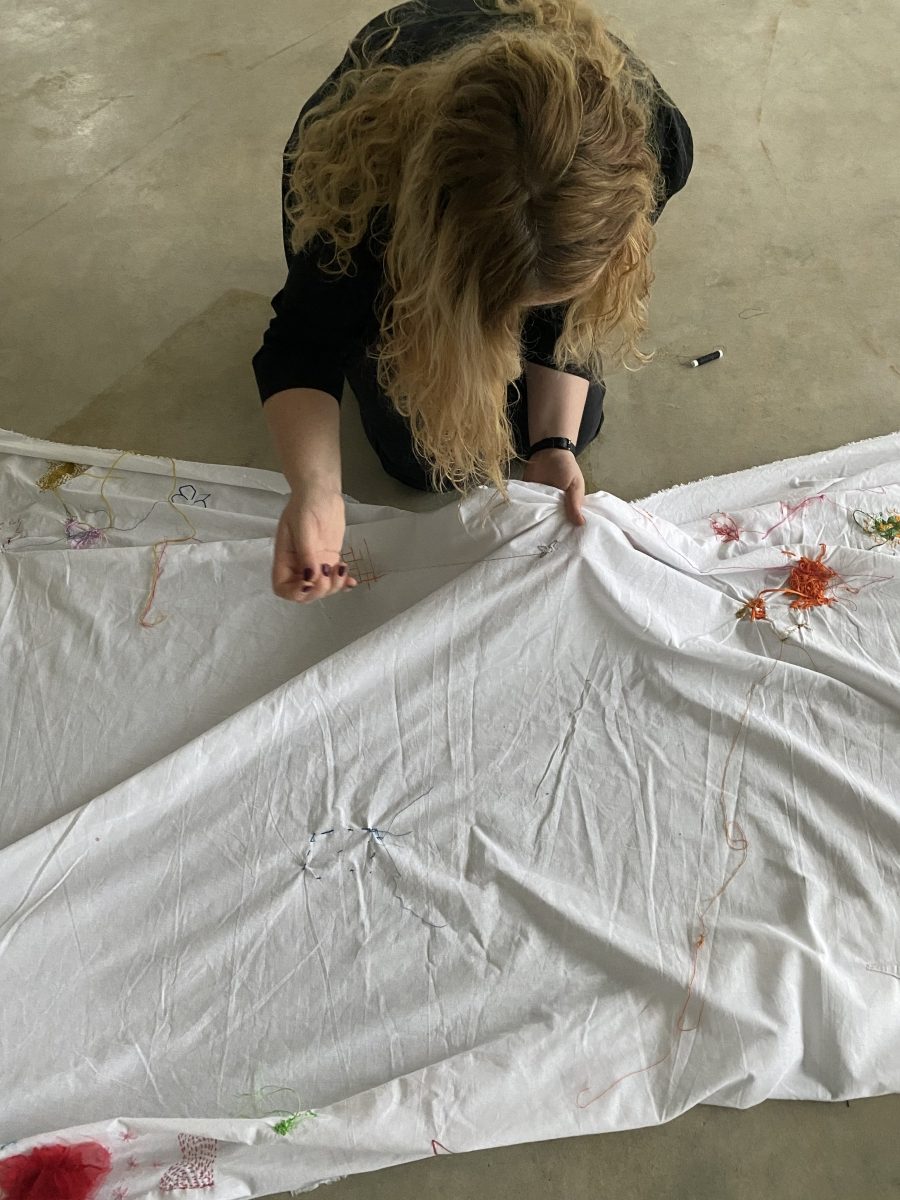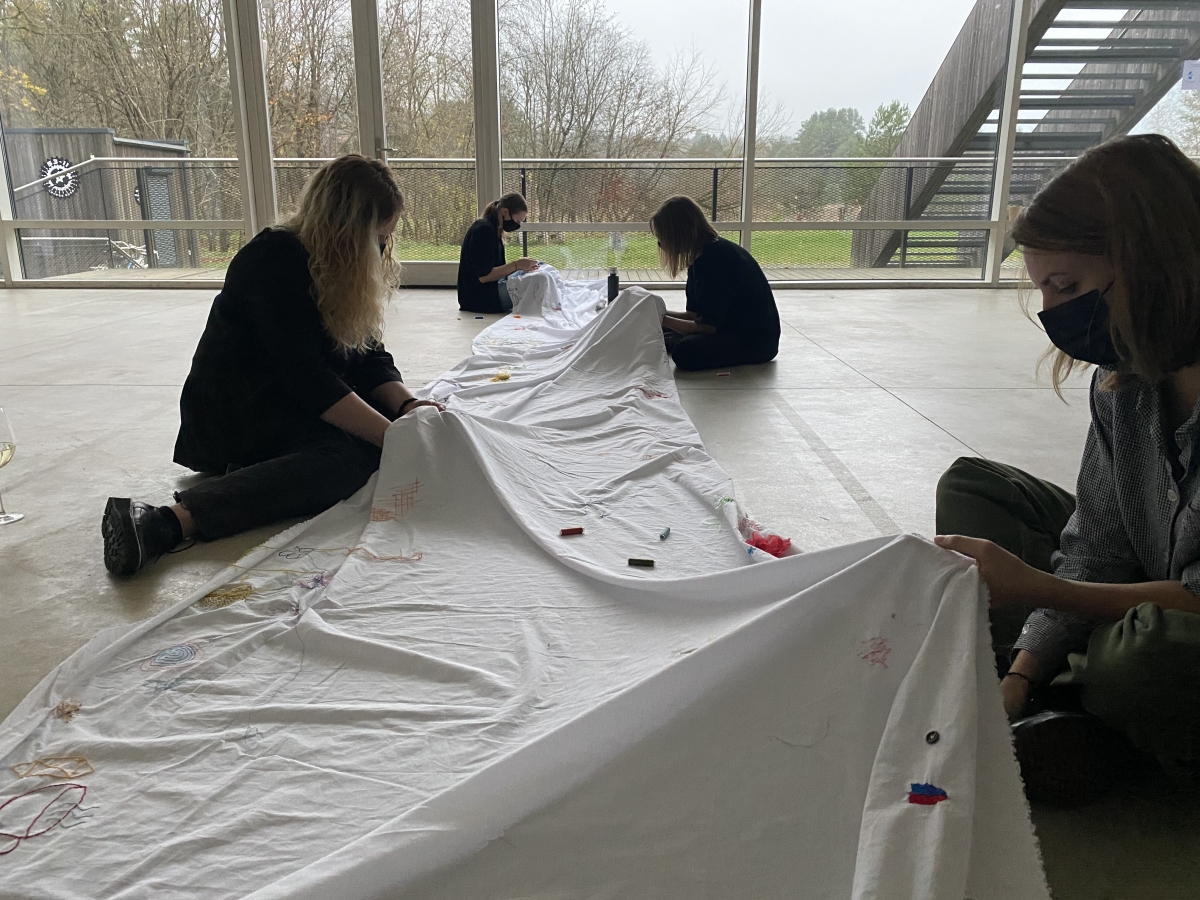When travelling in RIBOCCA this year, my friend and colleague Francesca Ferrarini introduced me to the artist Ruben Montini, which led us to work together later in Vilnius. Ruben was born in Oristano in Italy in 1986. He now lives and works between Lake Garda and Milan. He is the author of the performance This Anonymity is Subversive, which was put on in Vilnius at Tech Arts exhibition hall this November. The performance originally started in 2017, and it is still going on. It consists of a journey through every single country of the European Union, which the artist carries out together with the photographer Ela Bialkowska. The aim of the project is to invite the audience to collaborate on the execution of an artwork using the medium of hand-embroidery. Moving to each European country, it aims to create a colossal piece of hand embroidery as the result of cooperation between people living across the EU. This November, I was the curator of the performance This Anonymity is Subversive in Lithuania. Unfortunately, it was not possible to meet the artist Ruben Montini here in Vilnius, due to the pandemic, and the lockdown that started on the same day as the performance. It took place, but without spectators. We talked about This Anonymity is Subversive and other works by Ruben Montini.
UB: First, how should we introduce you briefly to a Baltic audience? As a younger-generation performance artist from Italy?
RM: Let me first of all thank you for this interview. I am very grateful to be able to present my work to a Baltic audience.
Indeed, I was born in Italy, and I recently moved back here from Berlin, where I spent many years after leaving London, where I graduated from Central St Martin’s, and after some years in Paris.
At a certain point, I realised that my work is very rooted in Italian culture, and also that in these difficult times, Italy needs voices to offer a more diverse contribution to the cultural and political conversation. I am not so young any more though. I am thirty-four years old now; and yes, I work mainly in performance, but also in textiles, video and drawing. So I would prefer to define myself simply as a visual artist.
UB: The reason for our conversation is your performance This Anonymity is Subversive, which I had the honour to curate in Vilnius, in the Tech Arts exhibition hall. Is it true that Vilnius in Lithuania is the seventeenth stop in the project? Can you say how the project started?
RM: Yes, Lithuania is the seventeenth country that the project has visited.
I began working on this project in 2016. On the day before the Brexit referendum, I had my first meeting with professors and the dean at the Royal School of Needlework in London, which hosted the first ‘stop’ in the project the following year. We were all extremely sure that the referendum would turn out differently; but we were wrong. I lived in the UK for a while, first in Manchester, and then in London, where I did my MA at CSM. The UK is the country where I studied and shaped my thoughts the most, not just from an academic point of view. Therefore, it would have been unthinkable to exclude the UK.
In this project, I wanted to combine my performative research with the textile part of my work, which is very performative as well. This mainly led my studio practice to the fact that I was constantly moving from one EU country to another, and how this was the result of my thoughts, the ideas of my generation, which has grown up taking the European Union for granted, and all of a sudden, our security was being taken away. Do you see what I mean? Our generation did not dream of building the EU, we already had it. We were born in it. It was there, and we never thought that one day, a very contingent day, it would disappear or turn into something very different to what we knew.
Back in 2015, I conceived Cosa Resta di Noi? Requiem, a colossal piece at the Oratoire du Louvre in Paris, in which I commissioned two composers of music to improvise the writing of a requiem for the European Union, using the main motifs from each national anthem. An orchestra would then try to play and sing along what the composers had just improvised. The audience was able to walk among the musicians and the singers during the gestation of the work.
I think This Anonymity is Subversive is similar to the work I presented in Paris. It’s a work that reflects on the EU, while I commission someone else to do it: through expertise in the performance in Paris, and in the latter case giving total freedom.

Performance ‘This Anonymity is Subversive’ at Tech Arts exhibition hall, Vilnius, 2020
UB: How have the local public perceived your work in these countries, and what are the differences between them?
RM: I think the approach varies from country to country, from the architecture of the space hosting the project and the weather, to the habits of the audience. We have to bear in mind so many little details that could drastically impact the way people get involved in the work. For instance, in London, the participants were highly skilled students and tutors at the RSN: the environment was therefore a school; whereas in southern countries, such as Italy, Cyprus and Greece, where the weather is warm, the work was displayed outdoors, and their tradition of ‘embroidery as an excuse to get together’ came out naturally. I believe the main goal of the work is, in fact, to create a community: to develop, through the activity itself, a sense of belonging, that could be extended to a wider community that will never physically meet, but metaphorically does on the surface of the sheet of the project.
UB: Why is there such a focus on the EU in this project? Your other works focus on such a wide spectrum of themes, such as queer culture and heir to the social claims of the 1960s and 1970s. Still, embroidery is like the main line or materiality in your works. How did you find it so?
RM: I began to perform live when I was still a student at the Accademia di Belle Arti in Venice. I was twenty years old when I performed my first work before an audience in an art gallery. I always loved the adrenalin of that specific moment when the artist and the audience share something extremely intense together. I started by reenacting iconic works by feminist artists, and I have always been fascinated by their radical position, and by the way artists such as Natalia LL, Valie Export, Marina Abramovic, Yoko Ono, Carolee Schneemann and Ana Mendieta, but also artists of the younger generation, such as Regina José Galindo, and (the early work of) Tania Bruguera, have used or are using performance to fight prejudice and gender inequality.
When I finished my studies, I looked at my family background, and Sardinia, the island where I grew up, as a place of richness both in terms of iconography and from a more narrating perspective. Themes that I would discuss and usually have different opinions about them with my mother, would become central topics in my art, while the female tradition of embroidery and stitching would finally define my works, in an attempt at reenacting clichés relating to the perception of women in Western society.
At the same time, going back to the EU, I have made several works reflecting on four continents: starting from a reinterpretation of the European flag made on a black velvet background with silk thread stars (2013); a pink version of the same flag to fight male chauvinist misinterpretation (2012); and again the work that I presented in Paris (2015); and many more.
UB: Unfortunately, you and your photographer could not participate in the event in Vilnius because of the situation with Covid-19. I have already seen masks put into and sewn into the cotton of the This Anonymity is Subversive project. How does this situation affect the project, and, in general, your other works and planned exhibitions?
RM: In March, at the beginning of the lockdown, I did not want to continue the project until we had the possibility to travel again. But after a couple of weeks living in the pandemic emergency, I realised that the project had to adapt to the new circumstances, as we were all doing. In fact, we did not stop our own lives: we adapted, and still are, to this new, unprecedented time in history. Therefore, the project travelled alone to Paris, to Lisbon, Malta, Bulgaria, Ireland … so many countries that I would have liked to visit but couldn’t. I believe this has given new power to the work, narrating our real contingent life: the work is now enriched with images of families stitching together in their dining room while in lockdown, small communities doing tiny embroideries in their private gardens and backyards.
UB: Isn’t it strange when your work or project is living its own life, travelling alone through other countries, meeting new people, and changing, while being sewn by local people in those countries? It kind of brings the work into other social contexts?
RM: The work has been open to different contributions and interpretations since the very beginning. What I miss most is my own encounter with the audience. Throughout these years working on the project, I realised that the EU is a melting pot of so many different cultures, attitudes, landscapes and stories that I did not know before: all the things that I learned from people I met on trips to different countries … That’s what I miss.
I would have loved to be able to visit the Baltic region, for instance, and meet its inhabitants, but it was not possible.

Performance ‘This Anonymity is Subversive’ at Tech Arts exhibition hall, Vilnius, 2020
UB: The performance has been travelling through EU countries for over three years now. Which countries are left? I heard that the last stop is going to be in Holland, where you have an invitation from the Marnhem Museum on 16 and 17 January. Is the plan still the same?
RM: In the Netherlands, This Anonymity is Subversive is part of ‘Living, Forgiving, Remembering’ at the Museum Arnhem from 4 October 2020 to 17 January 2021. For now, the event is still expected to take place on 16 and 17 January 2021, but I can definitely say that this is not going to be ‘the last stop’ any more, since some other events have been postponed due to Covid-19 restrictions.
UB: What will the final result of the performance look like?
RM: The project will eventually be shown as documentation of the entire journey through the EU: the embroidered sheet, photographs and videos of each ‘stop’.
We will also make a book that will illustrate the work in detail.
UB: Most of your works either use your own body (mostly early works) or embroidery by your own hands (except for This Anonymity is Subversive). Tell me why using your own body is so important to you?
RM: I usually use my own body in my most political works. We have never had a visual artist in Italy who used his body to fight homophobic prejudice as I do. I believe, as an artist, that it is my duty to raise awareness of certain topics that affect my daily life, and also to lend my voice to those who cannot scream, to those who live in remote areas and have no way of making their opinions heard. We are fighting right now to finally approve a law against homophobia in the Italian parliament.
UB: And I see a third direction in your work: text. I have seen it in your social media, you use it quite a lot in your work. How does text come into your work? What are your other creative plans for next year?
RM: I have been using text for a long time now, and I have been integrating it both into my performances (tattooing my body) and in my textile work. Sometimes I use quotes from different authors, sometimes my own writings. I have finished producing a solo show curated by Caroline Corbetta for Il Crepaccio which is exclusively showcased on Instagram, and it consists of five short videos in which a voice reads the emails I sent to my former boyfriends at the end of each love affair. This is the latest way I have been using my own words in my visual research.
At the moment, in fact, I am working on the publication of my very first book, which is a collection of my texts and some sketches I made, drawings that then became tapestries using my own lettering.
Next year, while finishing This Anonymity is Subversive, I will have my first museum exhibition in Spain, although everything is being rescheduled because of the pandemic … so we don’t know exactly what will happen.

Ruben Montini. Photo credits Ph. Ela Bialkowska. OKNOstudio

Performance ‘This Anonymity is Subversive’ at Tech Arts exhibition hall, Vilnius, 2020

Performance ‘This Anonymity is Subversive’ at Tech Arts exhibition hall, Vilnius, 2020


Performance ‘This Anonymity is Subversive’ at Tech Arts exhibition hall, Vilnius, 2020






























